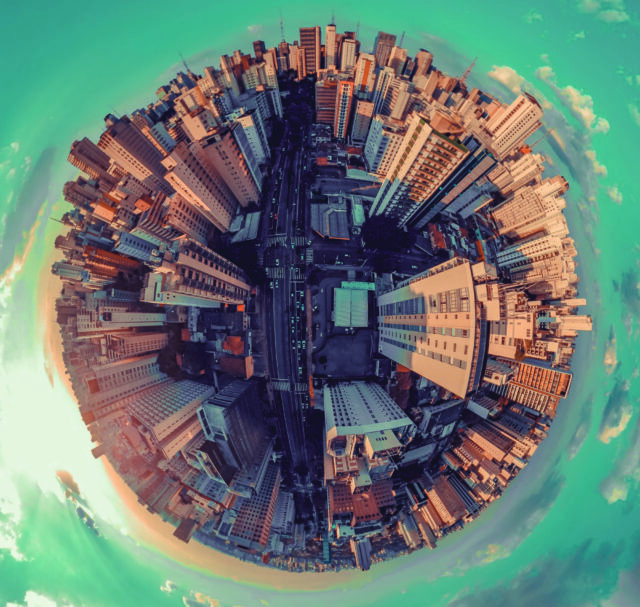
By Julia Szabo
When the COVID-19 quarantine first became “the new normal” and carbon dioxide emissions lowered dramatically, people around the globe stopped in their tracks to see astounding satellite images of normally heavily polluted points on the map: blue skies over once-overcast China, and crystal-clear views of the famously cloud-shrouded India Gate in New Delhi. As humankind appeared to face extinction, our home planet’s atmosphere was regenerating. Now, with pollution again painting it black as emissions rise to pre-pandemic levels, the novel coronavirus continues to keep the world on high alert, as doctors monitor patients while research scientists monitor the Earth’s vital stats. Their findings point to a definite link between air quality and viral severity, especially in urban metropolitan areas.
Dr. Qanta A. Ahmed, attending pulmonologist, sleep disorders specialist and critical care specialist, saw firsthand evidence of that link while treating COVID-19 patients at NYU Langone Hospital—Long Island in Mineola, New York. “Among many dramatic events that I witnessed, one comes to memory vividly,” recalls Ahmed, who also serves as associate professor of medicine at NYU Langone Long Island School of Medicine. “After attending patients for 50 days during my ICU rotation, managing the critically ill COVID-19 patients on mechanical ventilators, on the last day, one of my patients unexpectedly died. I was so perturbed, I requested an autopsy to understand what had happened. I spoke to the patient’s family and got consent for an autopsy, which was conducted by the chair of pathology, and that I attended in person. When she opened up the lungs, I saw severe damage caused by the COVID-19 infection, but the most striking thing was the lymph nodes: They were completely black, full of carbon. The pathologist observed this as a normal finding for all New Yorkers, given the high level of pollution in this area.”
Here was compelling anecdotal evidence of a contaminated environment’s deadly impact on health: “The patient was not a smoker, yet their lungs were scarred from air pollution,” Ahmed explains. “This is totally normal for anybody living in New York, where we have such impaired air quality that our lungs are constantly filtering particulate matter. If we were to open up your lungs, the pathologist told me, your lymph nodes would look the same. As lung specialists, we look at smoking, environmental injury—we don’t really think about air quality, instead being more focused on damaging behaviors like smoking and vaping. And yet—think of places like New Zealand, with its high environmental standards, where they had exceptional success at controlling the pandemic.”
It’s no coincidence that the world’s COVID-19 hotspots—Wuhan, China; Milan, Italy; and New York City—all have high levels of air pollution. “Scientists are beginning to study the relationship between air quality and the ability of the virus to cause infection and to not just spread,” says Ahmed, “but cause a devastating level of disease.”
According to a study published in October 2020 titled “Impact of meteorological conditions and air pollution on COVID-19 pandemic transmission in Italy” and authored by experts from Italy and Taiwan, COVID-19 pandemic transmission “prefers dry and cool environmental conditions, as well as polluted air. ”Pollution contaminates the air inside as well as out, and the study raises this important point in the discussion of air quality and COVID-19: “For those reasons,” the study says, “the virus might more easily spread in unfiltered air-conditioned indoor environments.” This suggests that the use of HEPA filtration must become standard procedure at hospitals in the very near future.
Environmental pollution and disease mitigation formed the twin campaign platform of running mates Joe Biden and Kamala Harris, whose incoming administration promises to prioritize the pandemic as well as implement plans to reduce our country’s carbon footprint. Requiring all Americans to wear face coverings has the added benefit of protecting the wearers from inhaling toxic emissions.
Appreciating the link between environment and lethal viral spread offers further incentive to cover one’s nose and mouth while social distancing. Shima Hamidi, PhD, Bloomberg assistant professor of American health in environmental challenges in the Department of Environmental Health & Engineering at Johns Hopkins Bloomberg School of Public Health, who has authored several scholarly articles on COVID-19, points out that face coverings may filter out particulate air, and “can help with direct transmission of the virus, as well as help with mitigating the air-quality impact that can indirectly affect COVID-19 infection and severity.”





